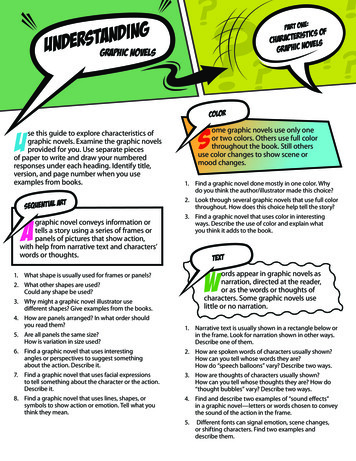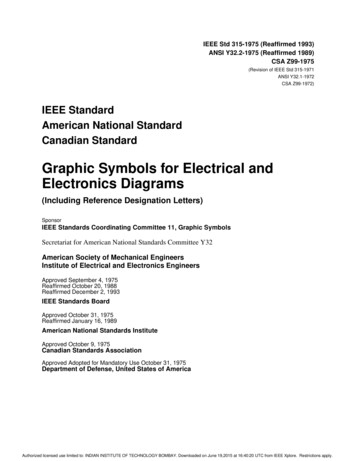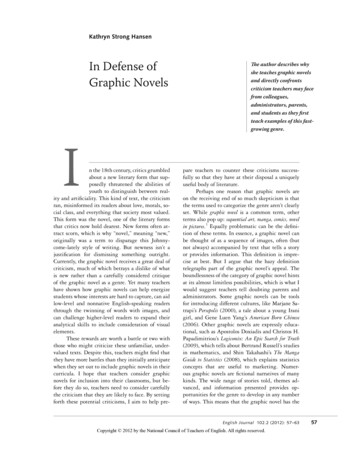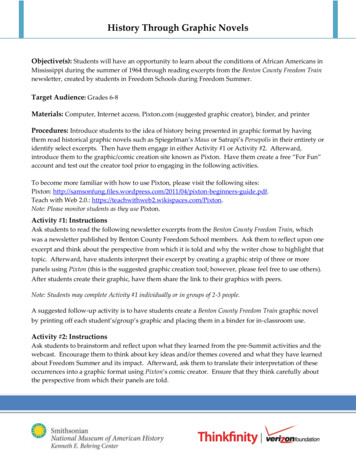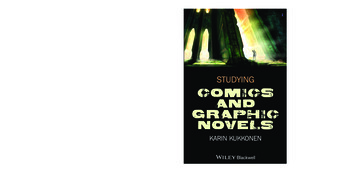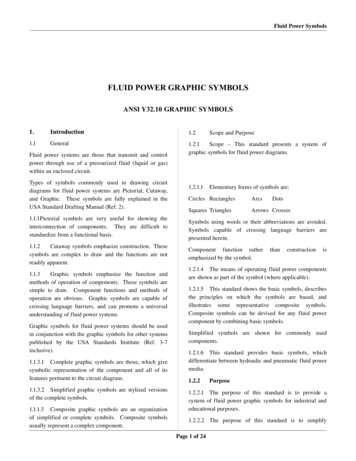
Transcription
Fluid Power SymbolsFLUID POWER GRAPHIC SYMBOLSANSI Y32.10 GRAPHIC SYMBOLS1.Introduction1.21.1General1.2.1Scope – This standard presents a system ofgraphic symbols for fluid power diagrams.Fluid power systems are those that transmit and controlpower through use of a pressurized fluid (liquid or gas)within an enclosed circuit.Types of symbols commonly used in drawing circuitdiagrams for fluid power systems are Pictorial, Cutaway,and Graphic. These symbols are fully explained in theUSA Standard Drafting Manual (Ref. 2).1.1.1Pictorial symbols are very useful for showing theinterconnection of components. They are difficult tostandardize from a functional basis.1.1.2Cutaway symbols emphasize construction. Thesesymbols are complex to draw and the functions are notreadily apparent.1.1.3Graphic symbols emphasize the function andmethods of operation of components. These symbols aresimple to draw. Component functions and methods ofoperation are obvious. Graphic symbols are capable ofcrossing language barriers, and can promote a universalunderstanding of fluid power systems.Graphic symbols for fluid power systems should be usedin conjunction with the graphic symbols for other systemspublished by the USA Standards Institute (Ref. 3 7inclusive).1.1.3.1 Complete graphic symbols are those, which givesymbolic representation of the component and all of itsfeatures pertinent to the circuit diagram.1.1.3.2 Simplified graphic symbols are stylized versionsof the complete symbols.1.1.1.3 Composite graphic symbols are an organizationof simplified or complete symbols. Composite symbolsusually represent a complex component.1.2.1.1Scope and PurposeElementary forms of symbols are:Circles RectanglesArcsDotsSquares TrianglesArrows CrossesSymbols using words or their abbreviations are avoided.Symbols capable of crossing language barriers arepresented herein.Component function ratheremphasized by the symbol.thanconstructionis1.2.1.4 The means of operating fluid power componentsare shown as part of the symbol (where applicable).1.2.1.5 This standard shows the basic symbols, describesthe principles on which the symbols are based, andillustrates some representative composite symbols.Composite symbols can be devised for any fluid powercomponent by combining basic symbols.Simplified symbols are shown for commonly usedcomponents.1.2.1.6 This standard provides basic symbols, whichdifferentiate between hydraulic and pneumatic fluid powermedia.1.2.2Purpose1.2.2.1 The purpose of this standard is to provide asystem of fluid power graphic symbols for industrial andeducational purposes.1.2.2.2 The purpose of this standard is to simplifyPage 1 of 24
Fluid Power Symbolsdesign, fabrication, analysis, and service of fluid powercircuits.1.2.2.3 The purpose of this standard is to provide fluidpower graphic symbols, which are internationallyrecognized.1.2.2.4 The purpose of this standard is to promoteuniversal understanding of fluid power systems.Page 2 of 24
Fluid Power Symbols2.Symbol Rules2.1Symbols show connections, flow paths, andfunctions of components represented. They can indicateconditions occurring during transition from on flow patharrangement to another.Symbols do not indicateconstruction, nor do they indicate values, such as pressure,flow rate, and other component settings.2.5.1Circle and Semi Circle2.5.1.1Large and small circles may be used to signifythat one component is the “main” and the otherthe bols do not indicate locations of ports,direction of shifting spools, or positions of actuators onactual components.2.3Symbols may be rotated or reversed withoutaltering their meaning except in the cases of: a.) Lines toReservoir, 4.1.1; b.) Vented Manifold, 4.1.2.3; c.)Accumulator, 4.2.2.4Line TechniqueKeep line widths approximately equal. Line width doesnot alter meaning of symbols.2.4.1Solid Line Main2.4.2Dash Line – PilotRectangle(Pilot line for control)2.4.3Dotted Line(Exhaust or Drain Line)2.4.42.6Letter combinations used as parts of graphicsymbols are not necessarily abbreviations.Center Line(Enclosure Outline)2.4.5Sensing Line – Same as line which it connects.2.4.6Lines Crossing (The intersectionnecessarily at a 90 angle.)isnotor2.4.7Lines Joiningor2.7In multiple envelope symbols, the flow conditionshown nearest an actuator symbol takes place when thatcontrol is caused or permitted to actuate.2.8Each symbol is drawn to show normal, at rest, orneutral condition of component unless multiple diagramsare furnish shown various phases of circuit operation.Show an actuator symbol for each flow path conditionpossessed by the component.2.9An arrow through a symbol at approximately 45degrees indicates that the component can be adjust orvaried.2.5Basic symbols. May be shown any suitable size.Size may be varied for emphasis or clarity. Relative sizesshould be maintained. (As in the following example.)Page 3 of 24
Fluid Power Symbols2.10An arrow parallel to the short side of a symbol,within the symbol, indicates that the component ispressure compensated.2.11A line terminating in a dot to represent athermometer is the symbol for temperature cause or effectSee Temperature Controls 7.9. Temperature indicators andRecorders 9.1.2 and Temperature Compensation 10.16.3and 10.16.4.3.6Line, Pneumatic (Outlet to Atmosphere).3.61.1Plain orifice, unconnectable3.6.2Connectable orifice (e.g. Thread)3.7Line with Fixed Restriction3.8Line, Flexible3.9Station, Testing, measurement, or power take off.3.9.1Plugged port.3.9.2Quick Disconnect3.9.3Without Checks2.12External ports are located where flow linesconnect to basic symbol, except where componentenclosure symbol is used.External ports are located at intersections of flow lines andcomponent enclosure symbol when enclosure is used, seeSection 11.2.13Rotating shafts are symbolized by an arrow whichindicates direction of rotation (assume arrow on near sideof shaft).3.Conductor, Fluid3.1 Line, Working (main)3.2 Line, Pilot (for control)3.3 Line, Exhaust and Liquid Drain3.4Line, sensing, etc. such as gauge lines shall bedrawn the same as the line to which it connects.3.5 Flow Direction of3.5.1Pneumatic3.5.2HydraulicPage 4 of 24CONNECTED3.9.4With Two ChecksDISCONNECTED
Fluid Power SymbolsCONNECTED3.9.5With One CheckCONNECTED3.11DISCONNECTED4.1.2.1Below Fluid Level4.1.2.2 Above Fluid LevelDISCONNECTED(The return line is drawn to terminate at the upright legs ofthe tank symbol.)Rotating Coupling4.1.2.3 Vented Manifold4.Energy Storage and Fluid Note: Reservoirs are conventionally drawn in thehorizontal plane. All lines enter and leave from above.4.1.1Reservoir with Connecting Lines Above FluidLevel4.2.1Accumulator, Spring Loaded4.2.2Accumulator, Gas Charged4.2.3Accumulator, WeightedBelow Fluid LevelShow line entering or leaving below reservoir only whensuch bottom connection is essential to circuit function.4.1.2Simplified symbolThe symbols are used as part of a complete circuit. Theyare analogous to the ground symbol of electrical diagrams. Several such symbolsmay be used in onediagram to represent the same reservoir.4.3Receiver4.4etc.)Energy Source (Pump, Compressor, Accumulator,This symbol may be used to represent a fluid power sourcewhich may be a pump, compressor, or another associatedsystem.HYDRAULICPage 5 of 24PNEUMATIC
Fluid Power SymbolsSimplified SymbolExample:5.Fluid ConditionersDevices, which control the physical characteristics of thefluid.Page 6 of 24
Fluid Power Symbols5.1Heat Exchanger5.1.1HeaterInside trianglesindicate theintroduction of heat.5.1.2Outside trianglesshow the heatingmedium is liquid.Outside trianglesshow the heatingmedium is gaseous.5.4Filter – Separator5.4.1With Manual Drain5.4.2With Automatic Drain5.5Desiccator (Chemical Dryer)5.6Lubricator5.6.1Less Drain5.6.2With Manual Drain6.Linear Devices6.1Cylinders, Hydraulic and Pneumatic6.1.1Single Acting6.1.2Double ActingCoolerorInside triangles indicate heat dissipation.or(Corners may be filled in to represent triangles.)5.1.3Temperature Controller (The temperature is to bemaintained between two predetermined limits.)or5.2Filter – Strainer5.3Separator5.3.1With Manual Drain5.3.2With Automatic Drain6.1.2.1 Single End Rod6.1.2.2 Double End RodPage 7 of 24
Fluid Power Symbols6.1.2.3 Fixed Cushion, Advance and Retract7.2.1Push Button7.2.2Lever7.2.3Pedal or Treadle7.3Mechanical7.4Detent6.1.2.4 Adjustable Cushion, Advance Only6.1.2.5 Use these symbols when diameter of rodcompared to diameter of bore is significant tocircuit function.NON CUSHION6.26.3CUSHION, ADVANCE ANDRETRACTPressure IntensifierServo Positioner (Simplified)Hydraulic6.4PneumaticDiscrete Positioner(Show a notch for each detent in the actual componentbeing symbolized. A short line indicates which detent isin use.) Detent may, for convenience, be positioned oneither end of symbol.7.5Pressure Compensated7.6Electrical7.6.1Solenoid (Single Winding)7.6.2Reversing MotorCombine two or more basic cylinder symbols.7.Actuators and Controls7.1Spring7.2Manual(Use as general symbol without indication of specifictype; i.e., foot, hand, leg, arm.)Page 8 of 24M7.7Pilot Pressure7.7.1Remote Supply
Fluid Power SymbolsPage 9 of 24
Fluid Power Symbols7.7.2Internal Supply7.9Thermal – A mechanical device responding tothermal change.7.7.3Actuation by Released PressureBy Remote Exhaust By Internal Return7.7.47.9.1Local Sensing7.9.2With Bulb for Remote SensingPilot Controlled, Spring Centered7.10ServoSimplified SymbolComplete Symbol7.7.5(This symbol contains representation for energy input,command input, and resultant output.)7.11Pilot DifferentialComposite Actuators (and, or, and/or)Basic . . One signal only causes thedevice to operateSimplified Symbol7.8Solenoid Pilot7.8.1Solenoid or PilotComplete SymbolAnd . ; One signal and a secondsignal both cause thedevice to operate.External Pilot SupplyOr . . One signal or the other signalcauses the device to operate.Internal Pilot Supply and Exhaust7.8.2Solenoid and PilotPage 10 of 24And/Or . . The solenoid and the pilotor the manual override alonecauses the device to operate.
Fluid Power SymbolsThe solenoid and the pilotor the manual overrideand the pilotThe solenoid and the pilotor a manual override andthe pilot or a manualoverride alone.Page 11 of 24
Fluid Power Symbols8.Rotary Devices8.1Basic Symbol8.2.3Variable Displacement, Pressure Compensated8.2.3.1 Unidirectional8.1.1With Ports8.1.2With Rotating Shaft, with control and with DrainSimplifiedComplete8.2.3.2 Bidirectional8.2Hydraulic Pump8.2.1Fixed aulic Motor8.3.1Fixed DisplacementComplete8.2.1.2 Bidirectional8.3.1.2 Bidirectional8.2.2Variable Displacement, Non compensated8.2.2.1 Unidirectional8.3.2Variable Displacement8.3.2.1 UnidirectionalSimplifiedComplete8.2.2.2 Bidirectional8.3.2.2 Bidirectional8.4SimplifiedPage 12 of 24CompletePump – Motor, Hydraulic8.4.1 Operating in one direction as a pump. Operatingin the other direction as a motor.
Fluid Power Symbols8.4.1.1 Complete Symbol8.6Motor, Pneumatic8.6.1Unidirectional8.4.1.2 Simplified Symbol8.4.2Operating one direction of flow as either a pumpor as a motor.8.4.2.1 Complete c8.7.2Pneumatic8.8Motors, Engines8.8.1Electric Motor8.4.2.2 Simplified Symbol8.4.3Operating in both directions of flow either as apump or as a motor. (Variable displacement, pressurecompensated shown.)8.4.3.1 Complete Symbol8.4.3.2 Simplified Symbol8.5Pump Pneumatic8.5.1Compressor, Fixed Displacement8.5.2Vacuum Pump, Fixed DisplacementIEC8.8.2Heat Engine (E.G. internal combustion engine.)9.Instruments and Accessories9.1Indicating and Recording9.1.1Pressure9.1.2Temperature9.1.3Flow Meter9.1.3.1 Flow RatePage 13 of 24
Fluid Power Symbols9.1.3.2 TotalizingPage 14 of 24
Fluid Power Symbols9.2Sensing9.2.1Venturi9.2.2Orifice Plate9.2.39.2.410.4Envelopes105Ports10.6Ports, Internally BlockedPitot TubeNozzleHydraulic9.3Accessories9.3.1Pressure Switch9.3.2Muffler10.10.3Multiple envelope valves capable of infinitepositioning between certain limits are symbolized as in10.2 above with the addition of horizontal bars, which aredrawn parallel to the envelope. The horizontal bars are theclues to the infinite positioning function possessed by thevalve represented.PneumaticValvesA basic valve symbol is composed of one or moreenvelopes with lines inside the envelope to represent flowpaths and flow conditioners between ports. Three symbolsystems are used to represent valve types: single envelope,both finite and infinite position; multiple envelope, finiteposition; and multiple envelope, infinite position.10.1In infinite position single envelope valves, theenvelope is imagined to move to illustrate how pressure orflow conditions are controlled as the valve is actuated.10.2Multiple envelopes symbolize valves providingmore than one finite flow path option for the fluid. Themultiple envelope moves to represent how flow pathschange when the valving element within the component isshifted to its finite positions.Symbol System 10.1Symbol System 10.210.7 Flow Paths, Internally Open (Symbol System 10.1and 10.2)SymbolSymbolSystemSystem10.110.210.8Flow Paths, Internally Open (Symbol System 10.3)10.9Two Way Valves (2 Ported Valves)10.9.1 On Off (Manual Shut Off)SimplifiedOffPage 15 of 24
Fluid Power SymbolsPage 16 of 24
Fluid Power SymbolsOn10.9210.10Three Way Valves10.10.1Two Position10.10.1.1 Normally OpenCheckSimplifiedComposite Symbol. Flow to the right is blocked. Flow tothe left is permitted.10.10.1.2 Normally Closed10.10.1.3 (Distributor Pressure is distributed first to oneport, then the other).10.93Check, Pilot Operated to Open10.10.1.4 Two Pressure10.94Check, Pilot Operated to Close10.9.5Two Way Valves10.10.2 Double Check Valve – Double check valves canbe built with and without “cross bleed”. Such valves withtwo poppets do not usually allow pressure to momentarily“cros
Types of symbols commonly used in drawing circuit diagrams for fluid power systems are Pictorial, Cutaway, and Graphic. These symbols are fully explained in the USA Standard Drafting Manual (Ref. 2). 1.1.1Pictorial symbols are very useful for showing the interconnection of components. They are difficult toFile Size: 443KBPage Count: 24
